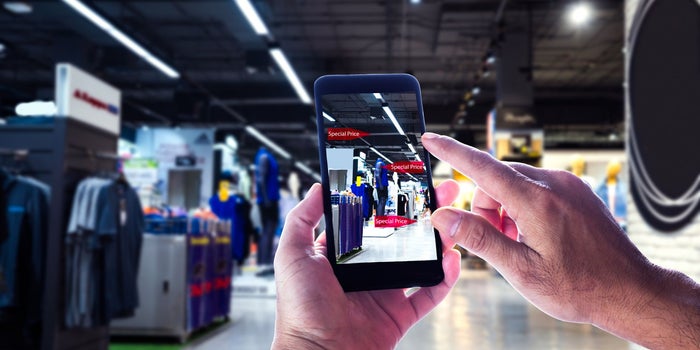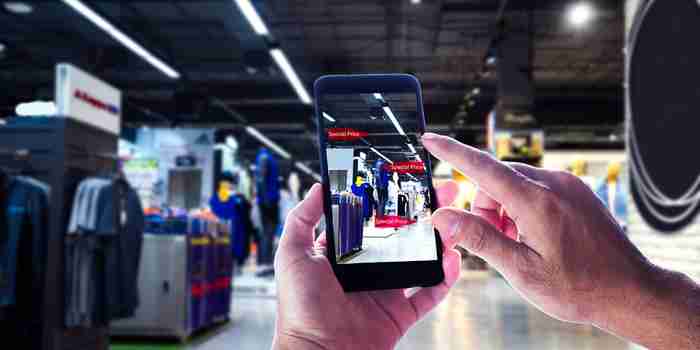First, this uber-shopping day, in 2017, eclipsed Black Friday by roughly $1.6 billion , Then, this year, 2018, Cyber Monday sales grew another 20 percent, approaching a historic mark of nearly $8 billion. Even Tim Cook stated as recently as 2017 that the technology “didn’t exist” to make quality AR glasses yet. The AR gold rush Despite what experts may say about the technological and financial limitations brands face when diving into the deep end of augmented reality, the numbers say that now is the time. What does that mean for business owners and marketers? Diving into the deep end Recently, my company, Drive Social Media, found itself thrown into AR with little-to-no experience developing anything quite in the same ballpark. "Spark" an engaging effect. This technology's approachable interface and intuitive intelligence make it simple for even novice designers to create compelling 3D AR graphics. Not only do consumers expect AR, but they are also willing to reward brands who use it. Make it feel natural. These players had to feel and operate with the same speed and effectiveness as a Walkman before the masses were ready to adopt.
The good news for your company is that AR is widely available to nearly anyone who wants to adapt it — using a tool which, would you believe, is on Facebook?

Opinions expressed by Entrepreneur contributors are their own.
It’s the most wonderful time of the year for retailers — more so now than ever. Cyber Monday has officially taken the reins as the most popular shopping day in the United States. First, this uber-shopping day, in 2017, eclipsed Black Friday by roughly $1.6 billion , Then, this year, 2018, Cyber Monday sales grew another 20 percent, approaching a historic mark of nearly $8 billion.
But as awesome as those stats may sound, an even more noticeable shift for retailers isn’t the compounding growth of Cyber Monday sales, it’s the spillage of what used to be Black Friday into a five-day event. Sales on Thanksgiving Day increased by 30 percent, and online sales on Black Friday also jumped by over 20 percent, year over year, ompared to last year.
All of which is to say that at this point, if you’re in the ecommerce game, there’s more to go around now — especially in this holiday period — than ever before. Yet, with all that noise and all those players on the field, how can you, as an online retailer, make your marketing stand out from the horde of your competitors’? This season, it’s easy: augmented reality (AR)
While AR technology isn’t new (Morton Heilig’s Sensorama was tested as long ago as 1956), its incubation period has been so prolonged, and its entrance into our daily lives so gradual, that many people today consider AR the same way they consider self-driving cars — on the verge of being ubiquitous but not quite ready for mass adoption.
Even Tim Cook stated as recently as 2017 that the technology “didn’t exist” to make quality AR glasses yet. That’s not to say that Cook was wrong, of course, but sentiments like his go a long way toward altering public perception.
The AR gold rush
Despite what experts may say about the technological and financial limitations brands face when diving into the deep end of augmented reality, the numbers say that now is the time. Consumers are primed and ready to be reached through AR technology, as Apple and Google already have placed over half a billion AR-capable devices in the wild. That number is expected to grow to over 4 billion by 2020 and generate over $200 billion in AR/VR spending by the same time, according to IDC.
What does that mean for business owners and marketers? There’s gold in them thar’ hills! A lot of it. In fact, global revenue from AR marketing is expected to vault from $430 million in 2018 to over $2.5 billion in 2022, according to eMarketer. Big brands like Ikea, Sephora, and Lowe’s are just a few examples of large brands that are leveraging AR to connect users more closely to their products and increase conversions.
Diving into the deep end
Recently, my company, Drive Social Media, found itself thrown into AR with little-to-no experience developing anything quite in the same ballpark. We’re a social media marketing agency that works with small business owners and franchises to create, place, optimize and track paid social ads. Notice how I didn’t mention anything about AR.
We’d had success working with professional sports organizations in the past and had been laser-focused on establishing a partnership with the NHL hockey team, the St. Louis Blues. The Blues were attractive to us on a number of levels, but what we really…

COMMENTS